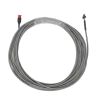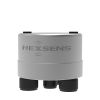SonTek-IQ Series Acoustic Doppler Flow Meters
Features
- Self-contained all-in-one design
- Proprietary flow algorithms for irrigation canals, natural streams and pipes
- Uses SonTek's exclusive SmartPulseHD adaptive sampling
- Expedited repair and warranty service
- Lifetime technical support
- More
Overview
The SonTek-IQ Series Acoustic Doppler Flow Meters are ideal for monitoring flows in canals, culverts, pipes, and natural streams. Four velocity beams profile water velocity along both the length and width of the channel, to ensure the best possible coverage and most accurate representation of the velocity field. The built-in pressure sensor and vertical acoustic beam work in tandem to measure water level. Simply input the channel geometry using the intuitive SonTek-IQ software and you are outputting flow data in minutes.
Mechanics
Capable of working both in man-made as well as natural channels, the SonTek-IQ can collect flow (area-velocity) and volume data in as little as 8 cm (3 in) of water. Its five-beam pulsed Doppler design is Modbus, SDI-12, RS232 and Analog ready. The SonTek-IQ installs with limited or no earthworks. With the SonTek-IQ, expect to get quality data for quality decision-making.
The SonTek-IQ Standard, the SonTek-IQ Plus and SonTek-IQ Pipe all operate at 3 MHz. The Standard model works in depths up to 1.5 m (5 ft), while the Plus and Pipe models are ideal for water depths up to 5m (16 ft). The SonTek-IQ Plus/Pipe also incorporates advanced post-processing functions, providing deeper insight into your flow and volume data. All models use SonTek's proprietary algorithm SmartPulseHD.
Benefits
- Self-contained all-in-one design
- Proprietary flow algorithms for irrigation canals, natural streams and pipes
- Uses SonTek's exclusive SmartPulseHD adaptive sampling
- Self-calibrating water level using vertical acoustic beam and pressure
- Standard package includes the SonTek-IQ, IQ software, easy mounting hardware, cable, adaptor and power supply
In The News
Cal Poly, San Luis Obispo Manages Monitoring Efforts in Morro Bay
California Polytechnic State University, San Luis Obispo (Cal Poly, SLO), has been monitoring Morro Bay for decades, and while the monitoring program has changed over the years, the dedication to monitoring the bay has remained the same. The project started in 2006 as a Packard Foundation-funded initiative to monitor water quality flowing in and out of Morro Bay. The goal at the time was to use the data collected to develop and inform an ecosystem-based management plan in collaboration with the Morro Bay National Estuary Program (MBNEP). Since the estuary was the focus at the time, researchers were monitoring water flowing into the estuary from Chorro Creek and Los Osos Creek.
Read MoreGreen Water in Green Bay: Using Data Buoys to Monitor the Southern Bay
While the bay of Green Bay has been referred to as the largest freshwater “estuary” in the world, the watershed hosts intensive agriculture and contributes one-third of Lake Michigan’s total phosphorus load. The Fox River flows into the bay, carrying excess nutrients largely the result of non-point source runoff from the watershed. With a history of deterioration extending well into the last century, the bay ecosystem suffered significant declines in water quality. This, in turn, stimulated major clean-up and ongoing restoration efforts to improve water quality. Tracking these changes is an important aspect of ecosystem management.
Read MoreCross-Border Sewage Contaminated Flows: Monitoring the Tijuana River
The Tijuana River runs across the US-Mexico boundary, flowing into and throughout southern California, carrying with it nutrients and contaminants throughout the estuary. In recent decades, the flows have been heavily polluted with untreated sewage from the City of Tijuana. The wastewater enters the greater Tijuana River estuary, impacting coastal communities and disrupting the natural environment. In order to better understand these cross-border flows, researchers out of San Diego University sought to monitor the waterway test the capabilities of in-situ sensors to measure the contaminated water. Natalie Mladenov and Trent Biggs were two of the researchers involved in the project, deploying a real-time monitoring system in May of 2021.
Read More

























